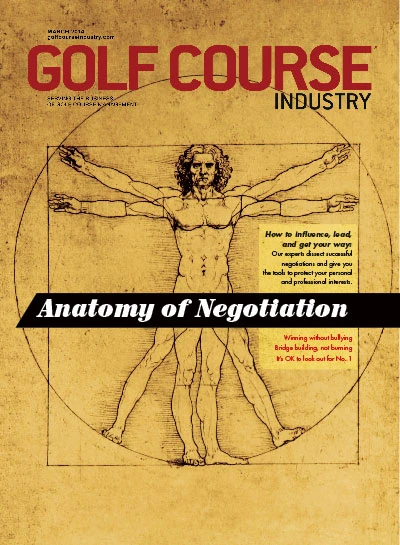 Tim Moraghan Tim Moraghan |
Have you been in the golf business long enough to remember the Basakwerd putter? Introduced in the 1980s, it was constructed with the shaft entering at the far end of the club head (what we think of as the toe), and was touted as a solution to all our putting problems. But like so many promised miracle cures, it didn’t help on the greens and didn’t hang around very long. I was reminded of this aptly named tool on the heels of the three golf-industry gatherings that kicked off 2014: the PGA Merchandise Show, the Golf Industry Show, and the USGA Annual Meeting. At all three, experts talked at length about the problems besetting golf and proposed solutions. In my opinion, most of the special programs, initiatives, best practices, and miracle cures are attacking the problem just the way the Basakwerd putter did: ass backwards. There are better, and simpler, ways to tackle the challenges. We should be careful about grasping at gimmicks. While I understand the concept behind 15-inch holes, oversized equipment, bunker bumpers, and kick ball on the course, these are unlikely to have a long-term effect on the game we know and love. Maybe some of those deviations from “real golf” will introduce people to the game and make them “real golfers.” Maybe. Wacky initiatives may get people out to the course once, but what does it take to truly hook people? Non-golfers are intimidated by the game because it’s hard and expensive, and they don’t want to embarrass themselves (particularly not at $150 a go). Can you blame them? What about attracting kids? I agree engaging youngsters is a good reason to modify equipment a little bit, just the way basketball, hockey, soccer, and other sports do. But, eventually kids have to grow into the equipment and need to play by the rules. Before we go too far afield, let’s take another look at the key issues we’re dealing with and see if they can be altered just a little bit to make golf more welcoming. (I’ll bet many of these ideas will be applauded by the current crop of “real golfers,” too.) Start with pace of play. Do we really need science to help get people around in four hours or less? Do you know what happens when beginners and average players are rushed? They make mistakes, lose balls, whiff, get frustrated, and, you can bet, start disengaging from the game. And let’s not get into the example that Tour players set on TV week after week. Until they are penalized for their excruciatingly slow routines, the rest of us have no reason to speed up ours. Fixing pace of play is simple, and it’s an area where those of us who maintain golf courses can take the lead. On busy days, set up the golf course a little easier. Point tee markers down the middle, trim back the rough, slow down the greens, put holes in accessible places, you get the idea. Since most average golfers can’t appreciate – and can’t take advantage of – the nuances of course set-up anyway, why penalize the majority to boost the egos of a few? (Save your tough pin positions for the club championship.) We also should encourage nine-hole rounds. They get people around faster and are, not surprisingly, more fun. And for most people, enough. As the experts most concerned with agronomy, how do some popular initiatives affect us? Reducing water, pesticides, and fertility is good for the environment, no question. But if these reductions negatively impact course conditioning, people may not want to play at a particular club or resort. Dues-paying members demand good conditions. How dare so-called industry “experts” tell our members that they can’t have what they want and are paying for. How dare they tell a superintendent not to do his job. Native areas on a course are attractive and good for the environment. But they still require maintenance and golfers are still going to hit $5 balls into them. Which leads to time spent looking for those balls, which leads to more frustration. Even with GPS tracking on golf carts and maintenance equipment that determines where native areas should be placed, golfers are still going to walk into them. So why have native areas at all? Same with multiple tees. It’s a no-brainer that golfers should play from the starting point that best suits their ability. “Tee it forward” is a great idea. Too bad more people don’t do it. Why are we building – and maintaining – five, six, or more sets of tees? Is a 10- or 15-yard difference really affecting the likelihood that someone will find the ideal yardage for his handicap index? Here’s a simple idea. Three teeing grounds, that’s it. Rate and slope them, then let golfers play from where they want. Can’t most people figure out that with three it’s roughly beginner, intermediate, and advanced? And while we’re at it, other than for competition, do we really need tee markers? Next: the Rules. I know the Rules of Golf and have studied them, taken the tests, and acted as a Rules official at numerous tournaments. Keep that in mind when I ask, “Who plays by the Rules of Golf every day?” Answer: About the same as the number of golfers who really know the Rules: Almost no one. I’m sorry, but strict adhesion to the Rules doesn’t matter unless someone is playing competitive golf. Tee it up in front of the markers, ground a club in a hazard, putt with the flagstick in the hole. You say against the rules. I say, who cares? Not the guys I play with. As well as I know the rules, I don’t want my friends, or yours, to adhere to them if it’s going to slow us down, cause more problems than they solve, and keep us from having fun. If we want to grow the game, we should stop being sticklers for the Rules. Or consider bifurcation. Yes, the “B word.” It’s time to consider two sets of Rules, one for competitive golf and one for what the rest of us play to have fun. The new president of the USGA, Tom O’Toole, said it can’t be called golf if it uses alternative rules or equipment standards. That’s fine, call it what you want, I’ll keep playing. Other sports vary their rules based on ability level: Think about T-ball for little kids or junior swimmers who swim 25 meters before advancing to 100 meters. Enact a set of rules for beginners, and as people grow with the game, they can grow into the rules. Two sets of rules – one for the best amateurs and professionals in tournament play, the other for everyone else in almost every other situation – won’t ruin the game. Can you tell me we all try to play by the same rules now? Do Phil Mickelson and I play the same game? No. But we play the concept of the same game. And once we all accept that concept, we can help golf grow.
Tim Moraghan, principal, ASPIRE Golf (tmoraghan@aspire-golf.com). Follow Tim’s blog, Golf Course Confidential at http://www.aspire-golf.com/buzz.html or on Twitter @TimMoraghan |

Explore the March 2014 Issue
Check out more from this issue and find your next story to read.
Latest from Golf Course Industry
- Turfco introduces riding applicator
- From the publisher’s pen: The golf guilt trip
- Architect Brian Curley breaks ground on new First Tee venue
- Turfco unveils new fairway topdresser and material handler
- Ignite Attachments adds new box plane and grapple
- Mackenzie & Ebert working on new Caribbean course
- Keswick Hall renovating Full Cry course ahead of big year
- The alpha wolf





